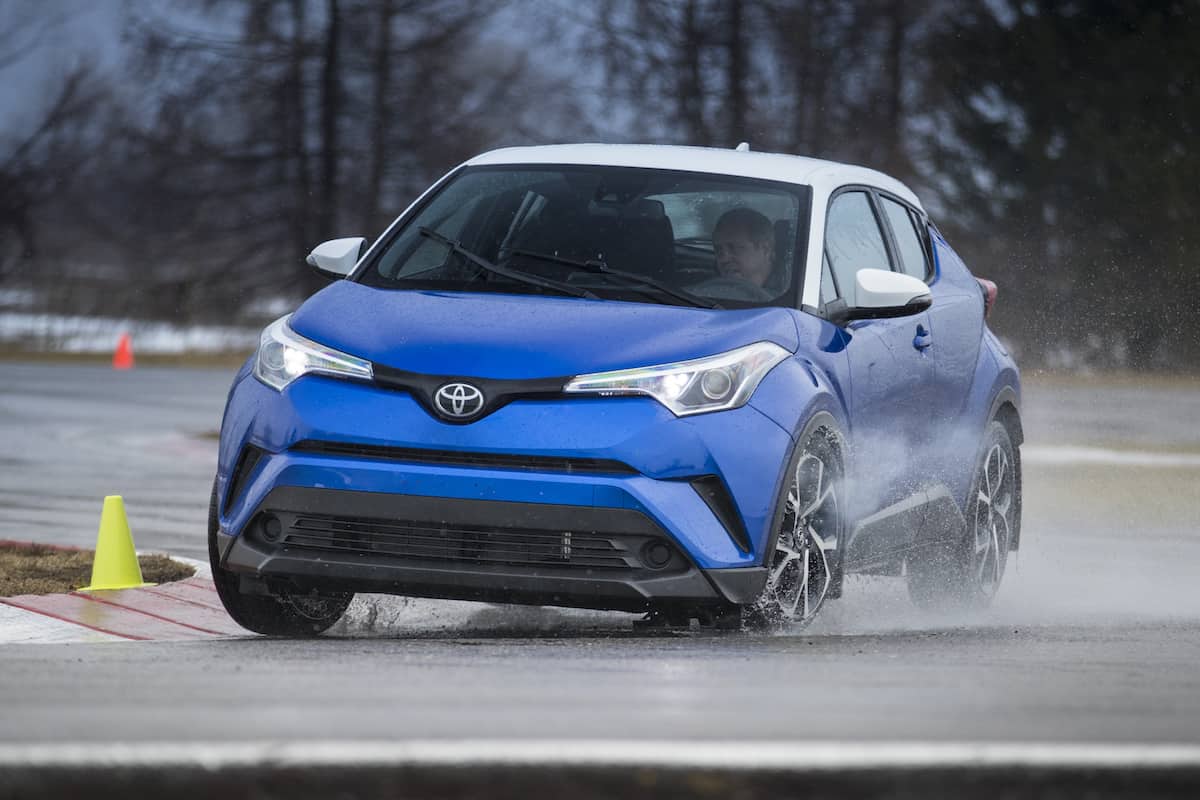Editor’s Note: The CH-R is discontinued as of 2023.
Toyota is ready to cash in on the public’s appetite for small utility vehicles with the new C-HR. This surprisingly extroverted-looking little car draws obvious comparisons to the Nissan Juke, whose similarly rakish profile first rolled into showrooms back in 2011. More recently, Nissan bolstered its small crossover range with the more plain-Jane Qashqai/Rogue Sport. Still, Toyota seems confident attaching its name to an eye-catching design (as Nissan first did) will help draw crossover shoppers into its showrooms.
Toyota’s New ‘Compact High Rider’
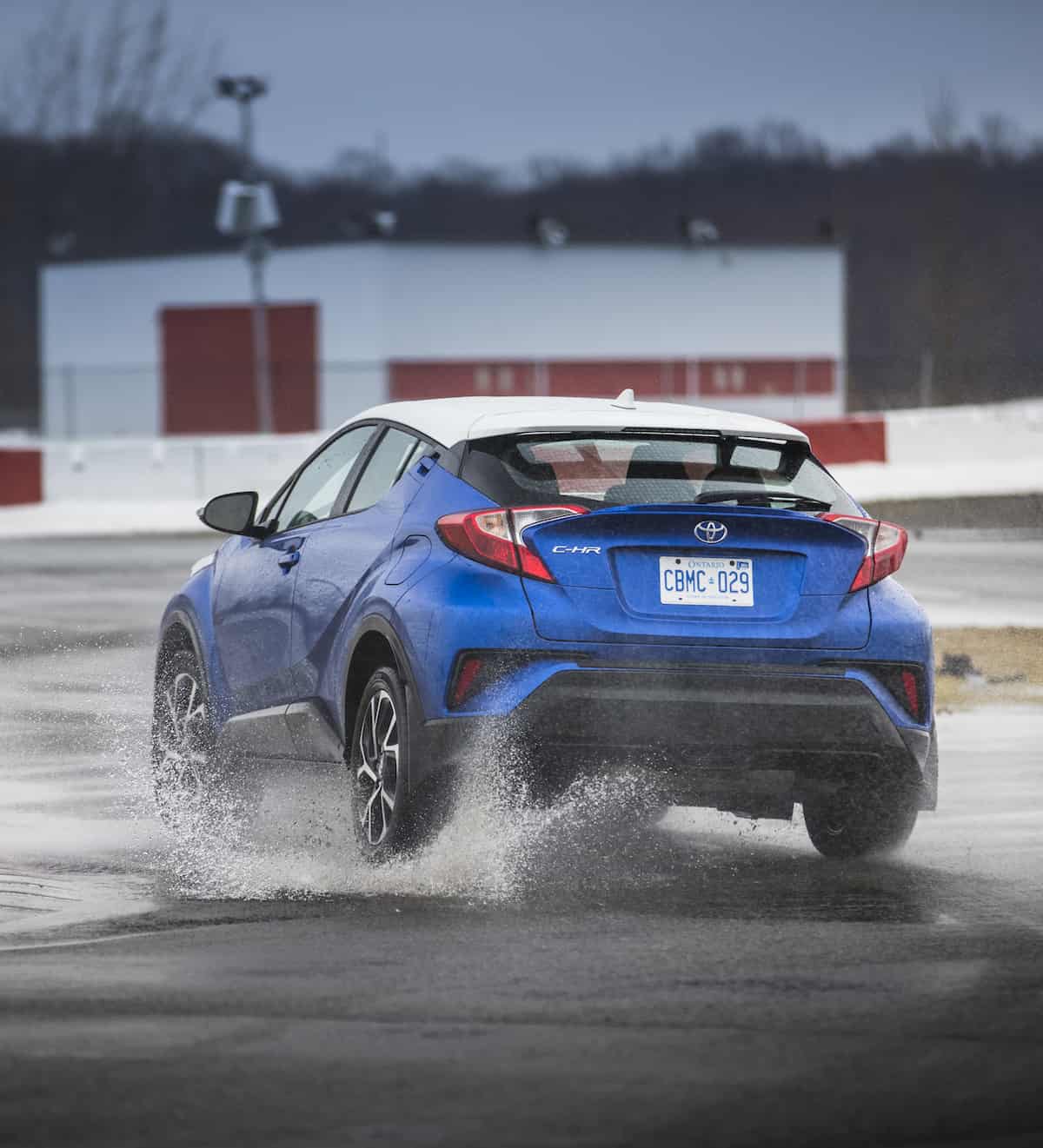
Toyota says C-HR stands for either “compact high rider” or “cross-hatch runabout.” Either way, add it to the list of small crossovers (CR-V, HR-V, CX-3, and RAV4) whose tailgate badges are already household names despite not being actual names like Nissan’s Rogue, Juke, and Qashqai/Rogue Sport (which is a real word for a group of tribal peoples from Iran).
C-HR Crossover’s Performance and Driving Dynamics

| Performance Features | Details |
|---|---|
| Engine | 2.0L Inline-4 |
| Horsepower | 144 hp @ 6,100 rpm |
| Torque | 139 lb-ft @ 3,900 rpm |
| Transmission | Continuously Variable Transmission (CVT) |
| Drivetrain | Front-Wheel Drive (FWD) |
Based on the Corolla platform
The CH-R is a front-wheel drive vehicle based on the same platform that underpins the 2018 Corolla. One of my neighbours was crestfallen when I told her the drive was really quite pedestrian (more on that shortly); another thought she was looking at a Honda, an understandable mistake considering the taillights are either a riff on or a rip-off of those on the Civic.
Power & Fuel Economy

| Fuel Economy | Measurement |
|---|---|
| City | 27 mpg (9.0 km/l) |
| Highway | 31 mpg (13.2 km/l) |
| Combined | 29 mpg (12.3 km/l) |
The C-HR’s looks promise a more interesting drive than most Toyotas are known for, but that turns out to be mostly for show. Its engine is a 2.0L four-cylinder that puts its modest 144 hp and 139 lb-ft of torque through a continuously variable automatic transmission (CVT). Those power figures are close to the average for the class, save for the Juke, whose 1.6-litre turbo motor (188 hp and 177 lb-ft) is the reason it’s a standout in the group.
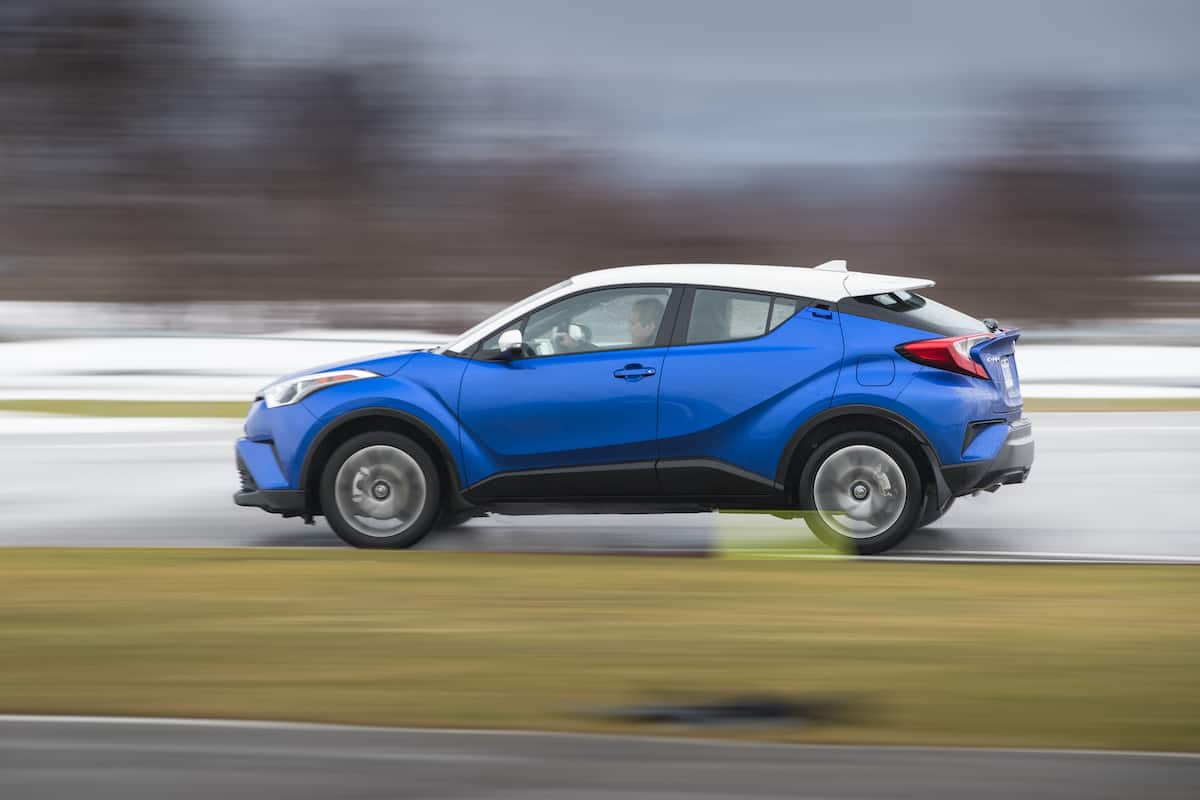
Acceleration from a stop is tepid, and things don’t pick up until the CVT lets the engine wind up towards its 3,800 rpm torque peak. The Mazda CX-3’s higher-compression engine generates 146 lb-ft at less than 3,000 and thus feels more lively off the line.
One promise the C-HR did live up to is its fuel consumption estimates of 8.7/7.5 L/100 km in city and highway driving, respectively: Our test car averaged 8.5 L/100 in mostly city driving.
Suspension and Footwork
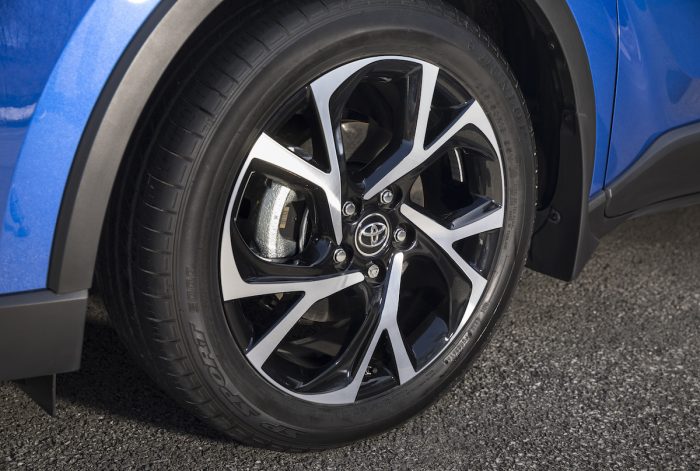
| Performance Features | Details |
|---|---|
| Suspension | Front: Independent MacPherson strut |
| Rear: Double-wishbone-type | |
| Brakes | Front: Ventilated Disc |
| Rear: Solid Disc | |
| Wheels | 18-inch Alloy Wheels |
| Tires | P225/50R18 |
If the powertrain is underwhelming, the C-HR’s suspension provides a great ride that manages to be both comfortable and firm, and very good at controlling body motions on rough roads. The overall feel is of a more substantial vehicle than the Honda HR-V, but the C-HR is less fun to toss into a quick corner than a Mazda CX-3 or the hot-hatch-like Juke.
Toyota’s taking a chance that buyers won’t miss the AWD option they’d get in the C-HR’s competitors. While that feature is all about improving all-weather traction in most crossovers, the Juke uses its sophisticated system to improve handling.
2018 Toyota C-HR Interior

| Interior Dimensions | Details |
|---|---|
| Front Headroom | 38.1 inches |
| Front Legroom | 43.5 inches |
| Rear Headroom | 38.3 inches |
| Rear Legroom | 31.7 inches |
| Cargo Volume | 19.0 cubic feet (rear seats up) |
| 36.4 cubic feet (rear seats folded) |
Despite the “high rider” moniker, the CH-R has a car-like ride height and seats positioned about as far off the pavement as you’d expect in a Corolla. Part of that sensation of substance comes from the relatively high beltline and dash, so you have to be okay with feeling very much ensconced within the car. My problem is that I like to sit up high in a vehicle for a commanding view out, but cranking the driver’s seat up puts the rearview mirror directly in my forward line of sight, a compromise I’m forced to make in many cars that put form and function on near-even footing. Large C-pillars also create big blind spots at the car’s rear corners.

Up front, you’ll find good headroom partly attributable to the apparent lack of a sunroof option, but the rear seat is a bigger surprise, offering adult-sized head- and legroom despite a sloping roofline. Still, rear-seat passengers suffer most from that high beltline and how it swoops up at the C-pillar. That design cue makes the rear quarters feel claustrophobic, which is unfortunate, given the decent space. Getting in and out of the back also requires caution to avoid knocking heads on the top of the door opening. Behind the rear seats is a cargo area about as large as most compact hatchbacks.
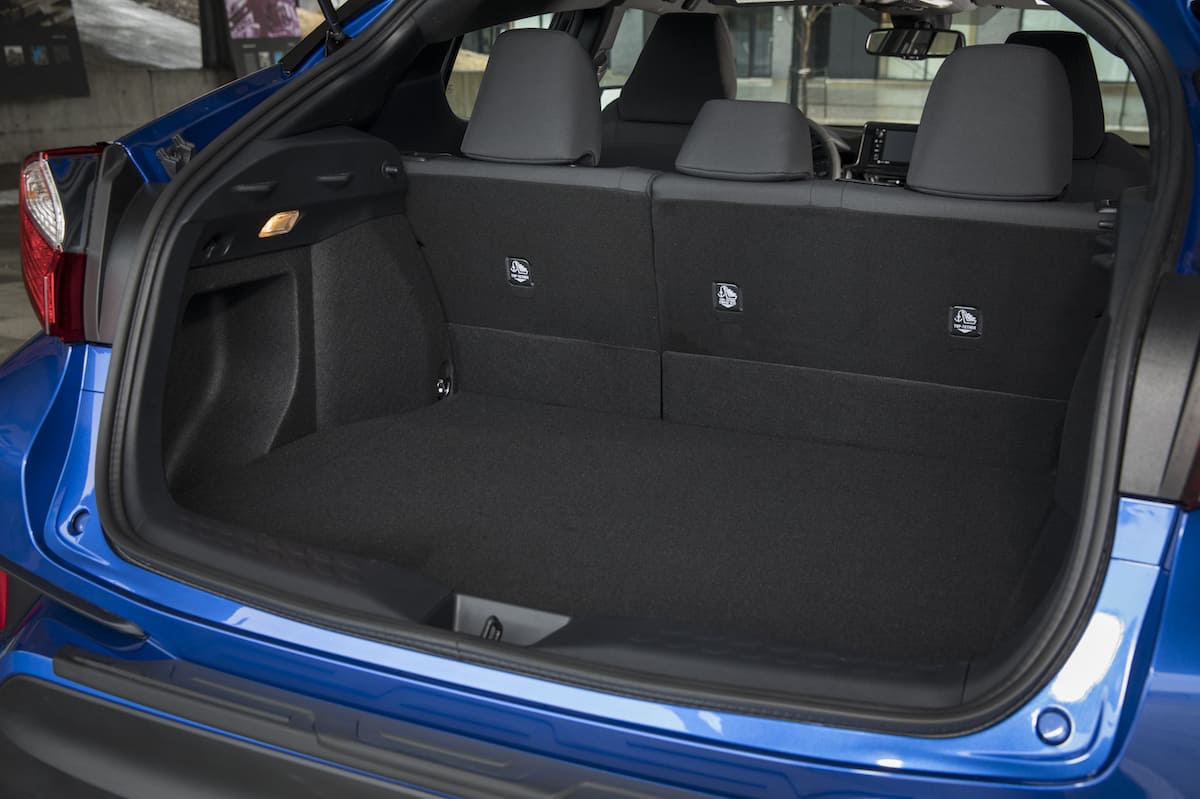
2018 Toyota C-HR XLE
The C-HR comes in a XLE trim priced at US$22,500 / C$24,690 (single model choice in Canada), which includes dual-zone automatic climate control, heated front seats, 17-inch wheels, leather-trimmed steering wheel and shifter, infotainment system with seven-inch touchscreen and a 4.2-inch multi-function display in the gauge cluster. And in the United States, there’s also an XLE Premium trim for US$24,350.
Configurations and Standard Features
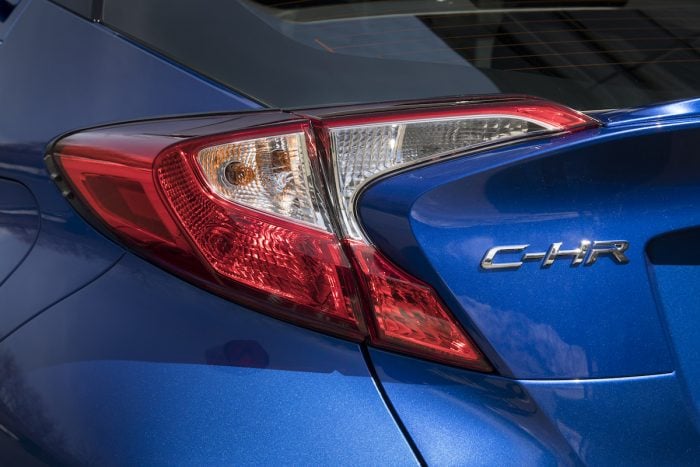
Also standard is Toyota’s Safety Sense suite of active safety features, bringing radar cruise control, automatic emergency braking, forward collision warning, and a pre-collision system with pedestrian detection, lane-departure alert with steering assist, and automatic high beams. Our test vehicle was fitted with a premium package that pushed the price to $26,290 and added 18-inch wheels, passive keyless entry, power-folding mirrors with puddle lamps, and a blind spot monitor with rear cross-traffic alert.
Honda won’t give you the HR-V’s active safety kit for less than $30,650, and Mazda asks $27,800 for a CX-3 with radar cruise, all-speed emergency braking, forward obstruction warning, and lane-departure warning. The Kia Soul splits the difference between these two with an EX Tech model that includes those items. Meanwhile, Hyundai has positioned its Tucson as something of an upscale option in this class, bundling its advanced safety items in upper-level trims that approach $40,000. Finally—and ironically—the Juke doesn’t offer any active safety features at all.
Takeaway
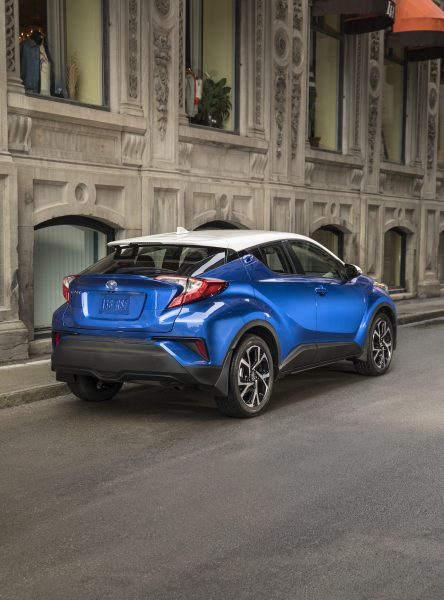
That’s a lot of money talk to conclude that the C-HR is a strong value among small crossovers, especially one with a look loaded with so much personality and solid practicality. I only wish its performance lived up to its appearance. The CH-R was discontinued for 2023; here are some other small Toyota crossover options.

